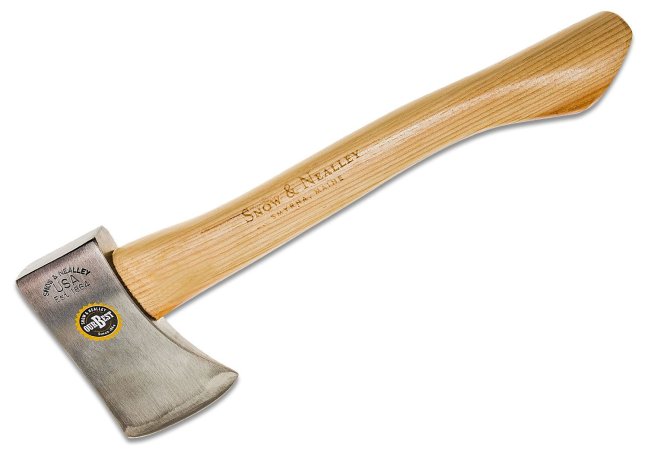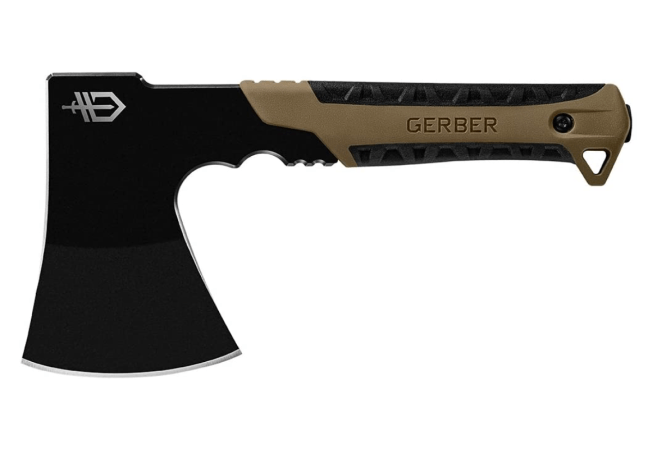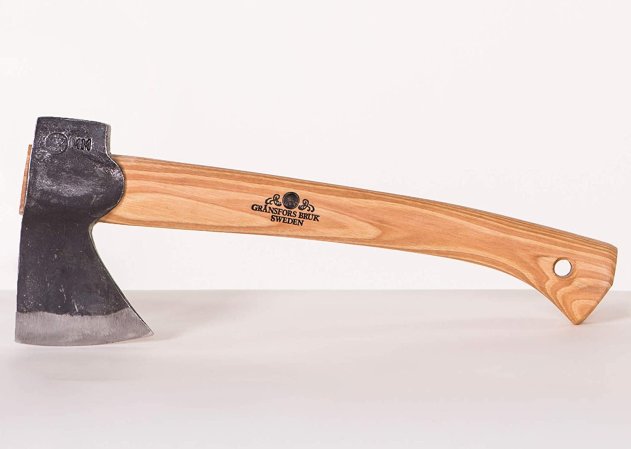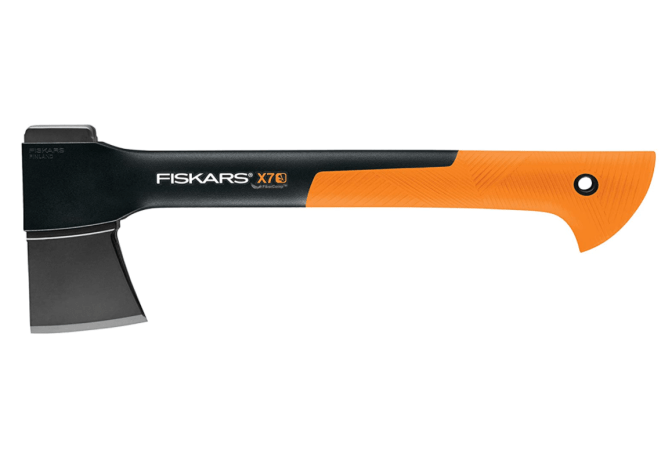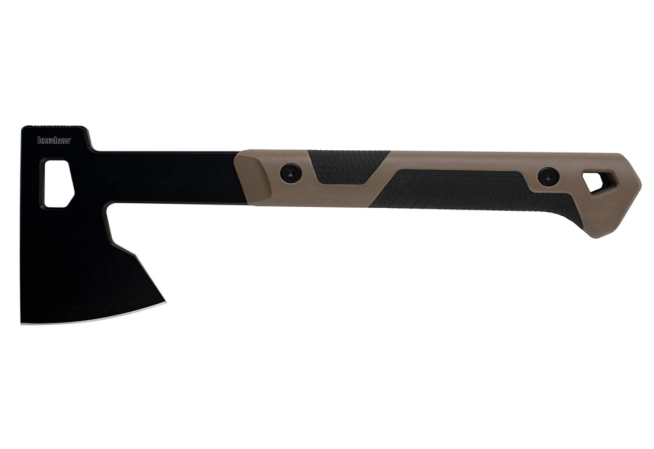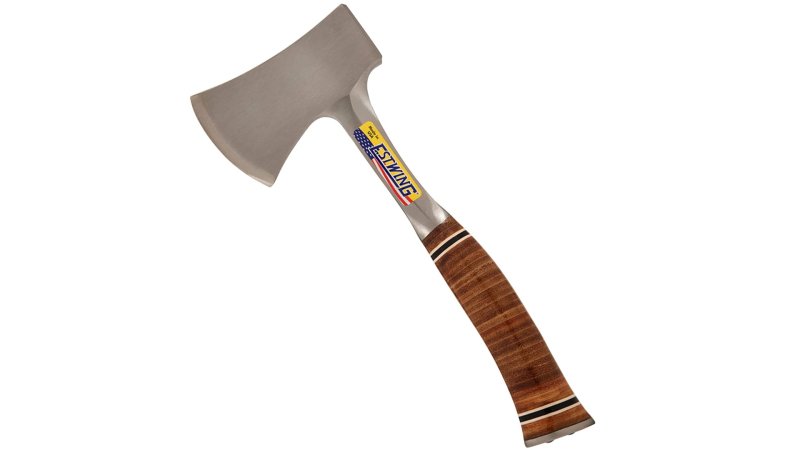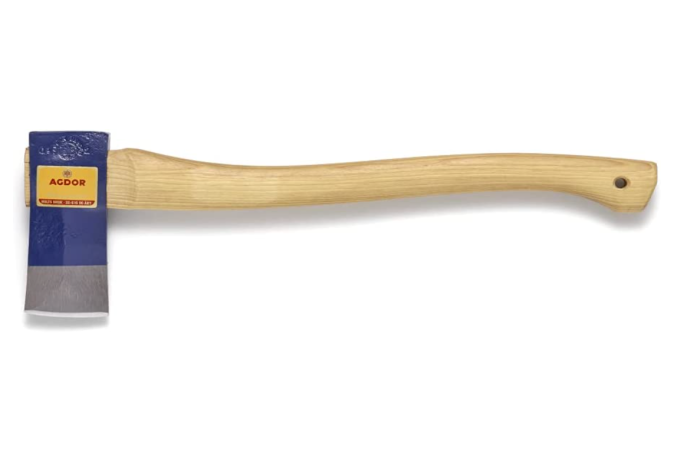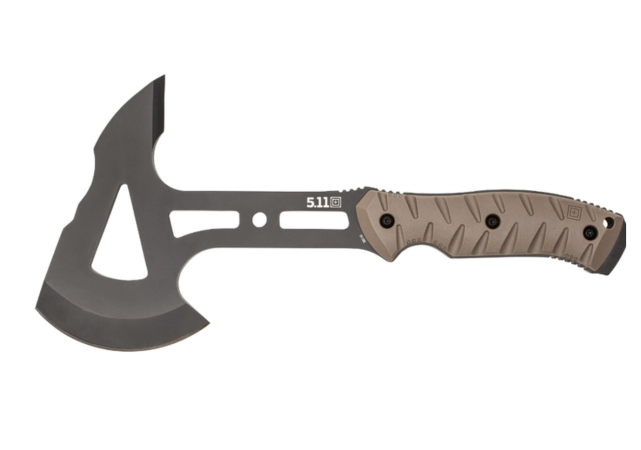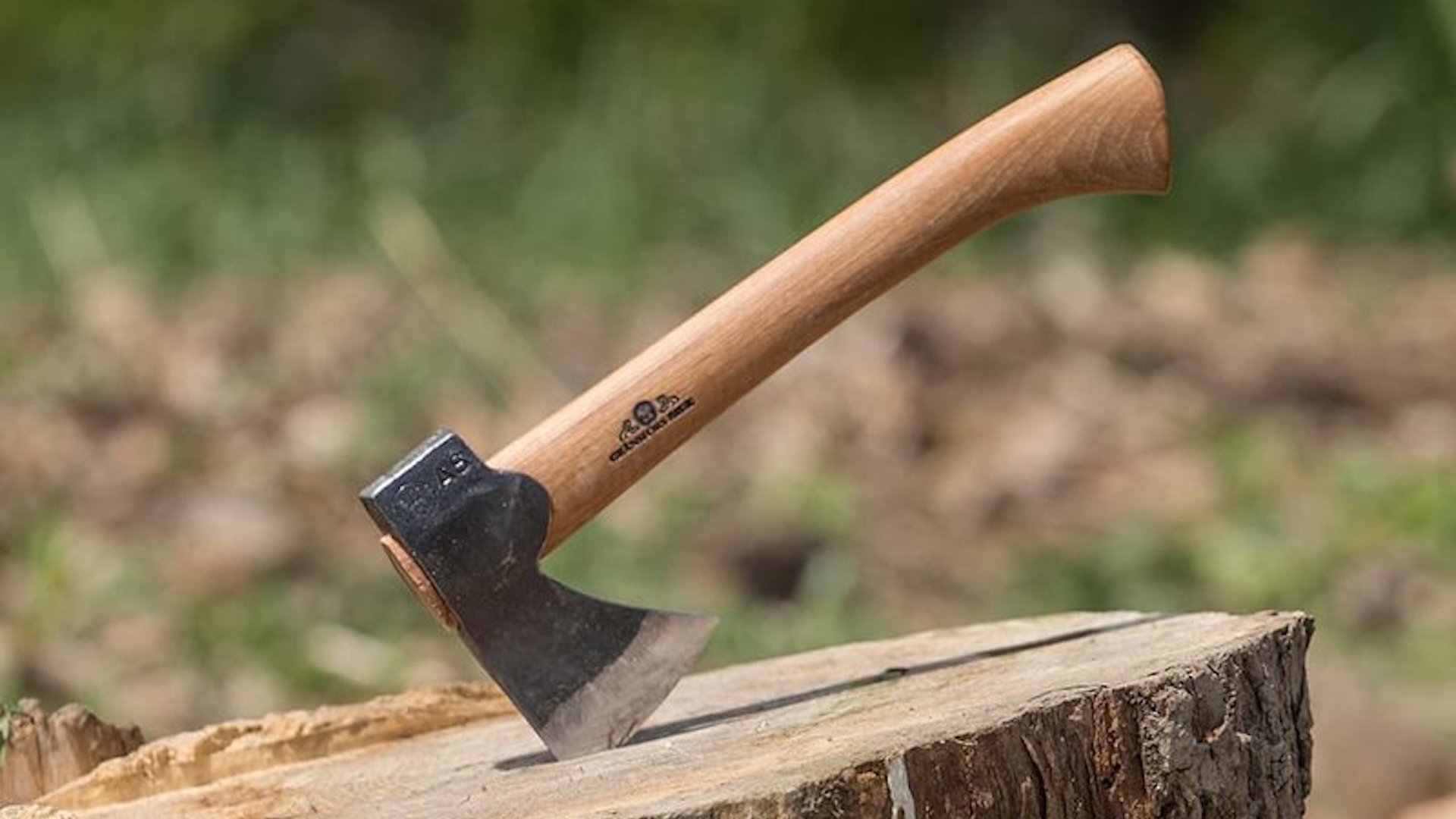

We may earn revenue from the products available on this page and participate in affiliate programs.
When I was a kid, I had to read a book called Hatchet by Gary Paulsen. The book follows the exploits of a young boy named Brian who, following a plane crash, manages to survive alone in the Canadian wilderness thanks in large part to his trusty hatchet and the bushcraft skills he develops along the way. It’s a great read for kids who love the outdoors that was inspired by the author’s life, which is somehow even more incredible than the book’s plot.
Besides being a fantastic read that even my fellow crayon-eating Marines can easily digest, you should also take a lesson from the main character and think about the tools you have at your disposal. Even if you aren’t dropped into the wild unknown all by your lonesome, being able to fend for yourself can make life a lot easier (and more rewarding). And sometimes, that tool is little more than a hatchet designed to conquer the great outdoors.
In the spirit of young Brian and his tale of survival, we’ve put together a guide to help you select the perfect hatchet for your next outdoor adventure. It doesn’t matter if you need a hardcore tactical hatchet or something that Ron Swanson would be proud of, we’ve got you covered.
- Best Overall: Snow & Nealley Outdoorsman’s Belt Axe
- Best Value: Gerber Pack Hatchet
- Editor’s Choice: Gransfors Bruk Wildlife Hatchet
- Best Composite: Fiskars X7
- Best Tactical: Kershaw Deschutes
- Best Tool: Estwing Sportsman’s Axe
- Best for Splitting: Hults Bruk Agdor 20 Splitting Axe
- Best That Thinks It’s a Tomahawk: 5.11 Tactical CFA Peacemaker Tomahawk
Best Overall
Snow u0026 Nealley Outdoorsman’s Belt Axe
Pros
- Built from the good stuff
- Comes with an old-school leather sheath
- Made in the U.S.
- Hits the sweet spot of price and quality
Cons
- Some need sharpening before the first use
- Be prepared for regular maintenance
- Bare-bones in terms of features
Product Specs
- Head: 1080 steel
- Handle: Hickory
- Weight: 2.3 pounds
- Overall length: 15.8 inches
- Sheath: Leather
Best Value
Gerber Pack Hatchet
Pros
- Super compact and portable
- Excellent performance in wet environments
- Full-tang construction increases stiffness
- Rubber grip absorbs shock
Cons
- Not big enough for true bushcraft
- Limited force can be generated with such a short handle
- Nylon sheath feels a little cheap
Product Specs
- Head: Stainless steel
- Handle: Rubber grip over stainless steel full tang
- Weight: 1.3 pounds
- Overall length: 9.5 inches
- Sheath: Nylon
Editor's Choice
Gransfors Bruk Wildlife Hatchet
Pros
- A tool to pass on to the next generation
- We love a wooden wedge
- Recycled steel reduces the guilt of cutting timber
- Pretty enough to hang on the wall
Cons
- Price is far beyond the competition
- Traditional tools are a labor of love
- Small production runs can limit availability
Product Specs
- Head: Recycled high-carbon steel
- Handle: Hickory
- Weight: 1.3 pounds
- Overall length: 13.8 inches
- Sheath: Leather
Best Composite
Fiskars X7
Pros
- Cutting-edge materials and technology
- Well-balanced and easy to swing
- Very reliable and low-maintenance
- Carrying handle built into the minimalist sheath
Cons
- Kind of feels like an office appliance
- Can’t be repaired in the field
- Composite handle can get slippery
Product Specs
- Head: Hardened forged carbon steel
- Handle: FiberComp composite
- Weight: 1.4 pounds
- Overall length: 16.5 inches
- Sheath: Plastic
Best Tactical
Kershaw Deschutes
Pros
- Full-tang, FDE, tactical goodness
- Stainless steel and composite grip are all-weather approved
- Light enough to carry all day
- Hard sheath adds protection
Cons
- Doesn’t generate as much force as a traditional hatchet
- Narrow head isn’t great for splitting wood
- Improved corrosion resistance at the expense of edge retention
Product Specs
- Head: 3Cr13 stainless steel
- Handle: Glass-filled nylon with rubber grip
- Weight: 1.6 pounds
- Overall length: 14 inches
- Sheath: Molded composite
Best Tool
Estwing Sportsman’s Axe
Pros
- One-piece metal construction is extremely durable
- Decades of proven success
- Available in 12- or 14-inch lengths
- Stacked leather handle is a thing of beauty
Cons
- Narrow head isn’t great for splitting
- Nylon sheath is a let-down compared to the leather handle
- Leather handle requires extra care and maintenance
Product Specs
- Head: Unspecified “solid American steel”
- Handle: Leather grip over steel full tang
- Weight: 1.9 pounds
- Overall length: 14 inches
- Sheath: Nylon
Best for Splitting
Hults Bruk Agdor 20 Splitting Axe
Pros
- A dedicated, one-handed splitter
- Perfect companion for your fire pit
- Fantastic attention to detail
- Impressive leather sheath included
Cons
- This hatchet is for splitting only
- Using it is a workout
- Fairly expensive compared to some alternatives
Product Specs
- Head: Premium Swedish steel
- Handle: Hickory
- Weight: 3.2 pounds
- Overall length: 20 inches
- Sheath: Leather
Best that Thinks it’s a Tomahawk
5.11 Tactical CFA Peacemaker Tomahawk
Pros
- Skeletonized to keep the full-tang design nice and light
- Handle is shaped to provide excellent grip
- Electro-coat finish protects against rust and corrosion
- Pick is great for piercing or digging
Cons
- Tomahawk label is a little misleading
- A great tool that gives off strong “that guy” vibes
- Versatile, but not the best for bushcraft
Product Specs
- Head: SCM 435 steel
- Handle: Fiberglass-reinforced nylon scales over steel full tang
- Weight: 1.8 pounds
- Overall length: 14 inches
- Sheath: Molded nylon
Why you should trust us
Buying quality everyday items can save you money. Buying quality survival and adventure gear can save your life. That’s why we take pride in finding the best equipment out there, whether it’s a badass bushcraft knife, an optic for your AR, or something less tangible. Every hatchet on this list was chosen for a reason. Some are time-tested favorites that have been outdoor staples for centuries, while others incorporate cutting-edge materials and manufacturing techniques. Whichever you choose, you’ll be that much better off the next time you find yourself chopping firewood in the backyard or crafting a shelter miles from civilization.
What’s the difference between a hatchet and an axe?
The obvious difference between axes and hatchets is size. Axes are two-handed tools that can be used to cut down trees and split logs. Specialized axes also exist for woodworking. Hatchets look similar but are small enough to be used with only one hand. Unlike tomahawks, they aren’t necessarily designed with throwing in mind. You can still chop down small trees with a hatchet, it’ll just take more time and effort.
Another distinction most people don’t know is the difference in metals used to build axes and hatchets. Because hatchets are so similar to hammers, the steel of the head is traditionally hardened to handle strikes against metal nails and stakes. Axes aren’t intended for this kind of thing, so the steel that’s used to make them is often much softer and can be damaged by a nail head. Know Prepare Survive has a detailed breakdown of these differences if you’re hungry for more.
Types of hatchets
Building a hatchet is simple enough, but there’s still some variety in the market that you should understand before picking one to strap to the side of your pack. The differences boil down to the materials that are used and the advantages they offer. The hatchets on this list can be divided into three easily identified categories.
Traditional hatchets
Hatchets have been around for thousands of years; since the days of chipping a rock into a crude edge and wedging it into a split branch. These days, traditional hatchets still look about like the ones that were used ages ago. You can spot a traditional hatchet by its wooden handle and sharpened steel edge.
This kind of hatchet is a timeless tool that’s popular among people who want to keep traditional bushcraft and woodworking skills alive. We can’t deny that singing a wooden handle has a satisfying feel to it that composite handles just can’t replicate. You might expect these hatchets to be the most affordable, but many are the product of very skilled labor and come at a hefty price as a result.
Composite hatchets
As synthetic materials developed, it was only natural for them to find their way into hand tools like hatchets. Many modern hatchets use composite handles that are lighter and stronger than wood. They don’t have quite the same feel, but there are good reasons to opt for one.
Composite hatchets are more durable than traditional hatchets. Water, rot, and dry air are no match for them so you can expect to get years out of yours with minimal maintenance. Sure, you can’t really repair one in the field, but breaking a composite hatchet is so unlikely that we wouldn’t be worried about it. Better yet, they’re surprisingly affordable.
Tactical hatchets
This gear guide wouldn’t be complete without some kind of tactical element, and you can bet your overpriced combat boots that we found some solid hatchets to scratch that itch. This is a legitimate category of its own, but there is a lot of crossover with composite hatchets due to the fact that wood is comparatively heavy and susceptible to the elements.
Tactical hatchets usually take lightness to a new level with thinner handles and skeletonized heads. That makes them easier to carry and–in a pinch–chuck downrange. They usually come with some kind of sheath or mounting system that’s compatible with the MOLLE on your assault pack.
Key features of hatchets
Hatchets are simple tools. There’s just a head and a handle (and maybe a wedge in the case of a wooden handle). It’s not complicated, but we always recommend getting to know your gear before you put it to use.
Head
A hatchet’s head takes the brunt of abuse and does most of the work. Even without a handle, you could beat it into a log like a wedge to split firewood. Most hatchets use carbon steel because it’s affordable, tough, and effective. Some heads use an alloy like 420 stainless steel to improve corrosion resistance at the expense of edge retention. If you really want to get into the weeds, Axeing has a great breakdown of the types of steel used to make axes, hatchets, and tomahawks.
Another consideration is shape. Narrow heads are good for chopping or cutting; wide heads are good for splitting. Hatchets are usually skewed toward cutting, although traditional hatchets seem to run wider than tactical hatchets by nature of their thick, wooden handles. If you want to learn more about the history and uses of various head shapes, Timber Gadgets is a helpful resource.
Handle
Historically, hatchets used a wooden handle. Wood is still relevant because it does a good job of insulating your hand from the shock of the head cutting into a log. It can also be replaced in the field easily enough in an emergency. On the downside, wood is vulnerable to damage from water, dry air, and insects. It requires maintenance to keep it in optimal condition.
Many modern hatchets use composite handles that are lighter and more durable than wood. Many people consider these to be less comfortable in the hand. Some even use separate materials for the shaft and the grip of the handle. If you plan on spending a lot of time in the elements, this can be a better option than wood.
Benefits of hatchets
Size
Hatchets have been in use since before recorded history and they’re still as useful as ever. Would we rather cut a tree down with an axe or chainsaw? Of course, but we don’t always want to carry a big axe or a chainsaw, fuel, and spare parts. Having something small and portable is a great asset, even if it’s just your backup plan. The common-sense rule is that the more wood you have to cut, the bigger your axe should be. Hatchets are built to cut enough wood to last all night rather than all winter.
The hatchets we picked for this gear guide are small enough to strap to the side of a hiking pack or wear on your belt. Modern variations use composite materials and minimalist designs that make them lighter than ever without compromising strength. Many can also be used as a hammer, and combining two tools into one is always a nice perk.
Utility
If you watch as many survival shows as we do, you know that hatchets are very versatile. With enough time and effort, they can cut down anything a felling axe can cut down. They can strip branches relatively efficiently. They may not be as efficient as a burly splitting maul, but you can split logs if you need to and even shape them to build a shelter or tool.
In a lot of ways, a hatchet is like an old truck or a trusty 30-30. There are better tools out there, but each can get you through just about anything if you know how to use it. If nothing else, a hatchet is a great excuse to get out of the house and practice a new bushcraft skill.
Easy maintenance
If you’ve ever been lucky enough to visit a well-stocked workshop, you probably noticed a lot of old tools lying around. Hell, my dad is still using hand tools that belonged to my great-grandfather. That’s because tools as simple as a hatchet can last forever if you take care of them.
Sharpening a hatchet is as simple as running a file and whetstone across the head. Replacing the wooden handle on a traditional hatchet is also simple, easy, and cheap. As long as you keep exposure to water under control and maintain the edge, your hatchet can easily become a lifelong asset.
Pricing considerations for hatchets
This is usually the point in the gear guide where we insert words of caution against cheap products and call out a few exceptions to the rule. This time is different though, and we credit that to the fact that hatchets are incredibly simple and easy to produce.
Budget
For less than $50, you can take your pick from a range of solid traditional and composite hatchets. Kick it old school with the Estwing Sportsman’s Axe or strap the compact Gerber Pack Hatchet to your tactical go bag. There are certainly valid reasons to spend more, but it’s not a prerequisite to getting a good piece of gear.
Mid-range
By increasing your budget to between $50 and $100, you’ll get access to higher quality materials and craftsmanship. If you plan on carrying your hatchet outdoors rather than using it primarily in the garage and around the yard, spending a little extra on something more durable might be a worthwhile investment. Just remember that every hatchet will require some degree of maintenance.
Hatchets like the Snow & Nealley Outdoorsman’s Belt Axe and Kershaw Deschutes are two examples of traditional and modern hatchets that can withstand the elements and the test of time. They take two different approaches but are equally valuable when you need a rugged cutting tool.
Premium
There aren’t a lot of hatchets north of the $100 line, but the few that we picked for this gear guide are well-built, specialized equipment that can justify the hefty asking price. In this price range, look for premium materials and excellent build quality.
The Gransfors Bruk Wildlife hatchet is an example of an outstanding hand-built hatchet that can raise a campsite from the forest floor and look damn good doing it. The 5.11 Tactical CFA Peacemaker Tomahawk is tough enough to chop wood and light enough to throw. Both are great choices if you have the money. If cost were no issue, I’d honestly buy one of each.
How we chose our top picks
We’re always looking for quality gear that can stand up to years of use. With that established, we sought out hatchets that span from old-school classics to modern tools that incorporate the latest materials and designs. We ruled out axes, which are so much larger that they serve a very different purpose and could use a gear guide of their own. We also didn’t include tomahawks in the traditional sense; those with a narrow head and built for throwing. Some of the products here might be called axes or tomahawks in the description, but their short handles and broad cutting edges make them hatchets in our book.
FAQs on hatchets
You’ve got questions, Task & Purpose has answers.
Q: Are hatchets and tomahawks the same thing?
A: Hatchets and tomahawks are very similar, but tomahawks place more of an emphasis on throwing and lightweight design. Hatchets tend to be heavier and more focused on chopping wood than striking a target.
Q: How do I choose between a hatchet and an axe?
A: This is a pretty easy choice that comes down to space. If you’re able to keep an axe in your garage or vehicle, it will be much more efficient than a hatchet. If you’re traveling by foot or tight on space, a hatchet provides quite a bit of cutting power in a more portable package.
Q: How do I sharpen a hatchet?
A: We’re sure everyone has a preferred method, but sharpening a hatchet is very similar to sharpening a knife. Depending on how beat up the edge is, you might need to use a file before busting out the whetstone.
